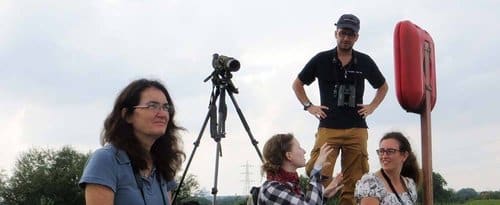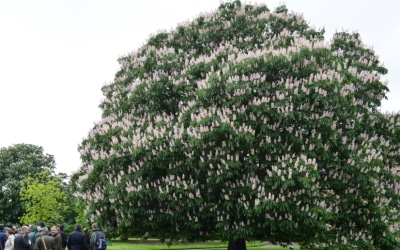David Darrell-Lambert

GiGL’s Board of Directors are central to our work and our success. Their commitment and expertise helps guide GiGL and keeps us moving forward and developing. Directors are on the front line of biodiversity and open space work in the capital. They are GiGL service users and contribute to our data banks, as well as serving as ambassadors for GiGL.
David Darrell-Lambert is GiGL CIC’s treasurer. He runs a successful ecological consultancy specialising in ornithological survey work. This experience comes in handy when keeping an expert eye on GiGL’s finances. David was a long-standing chair of the Ornithological Section of the London Natural History Society as well as of their Records Committee. He is an excellent trainer, and recently took the GiGL team birding for the day, teaching them recording techniques and ID skills.
Town or countryside?
Both. I love a bit of urban action and rural as well. Can I have rurban?
Summer or winter?
What about spring and autumn? In the bird world they both overlap so it covers a long period for me. For example, green sandpipers return in June for the autumn migration while marsh warbler are still coming back. I love all the seasons. There’s always lots to see, hear, enjoy and immerse yourself in.
Early bird or night owl?
Early bird. I like being out while it is still dark so I can see the first rays of light breaking on the horizon and see and hear all those birds waking up; whether it’s a dawn chorus or the first flight of migrating meadow pipits.

Outdoor or indoors?
Outdoors
Plants or animals?
Animals
We know you have a passion for birds. What is it about them that you love so much? Do you have a favourite?
What do I like about them? Er, well it used to be the challenge of identifying them or working out what race it was or of ageing them. Now I enjoy listening to songs and calls or watching their behaviour. In the last few years I have been attempting to work out migration routes across the capital. We are inundated with thousands of migrants every year and sometimes you can witness large scale migration right on your doorstep. Waiting for a bus in Tottenham, I watched hundreds of woodpigeons migrating in a few minutes. Another week, I counted just under four and half thousand in half an hour heading south by Dartford Bridge. Amazing stuff. My favourite species has varied over the years. In the early 1990s I was into warblers and by the end of the decade I was into raptors and gulls.
Hhhmm, one favourite bird? Firecrest, they always brighten up a day.
What is your favourite Greater London open space and why?
Tottenham Cemetery. I cut my teeth there learning a lot about birds. I learned how the weather affected bird migration (two days of east winds for the migrants from the continent to hit there) and started looking in more detail at moult sequences and ageing birds in the field. I have lots and lots of fond memories there. I’ve also had some long days with nothing much to watch.
What’s your first environmental memory?
Throwing stones at Minsmere RSPB in the late 1970s and getting an ear full from the warden. I wasn’t into birds then and had been dragged there by my parents. In 1979, Ms Anderson from Bruce Grove Junior School took my class to Rye Meads RSPB reserve where the warden showed us the different footprints of coots and moorhens. I went bananas over this experience and thereafter spent as much time as I could looking at birds. I got my father to take me up and down the country in pursuit of birds, mostly on public transport.
Who or what inspires you?
I was helping out at the A Vision for Nature conference organised by A Focus On Nature the other month. It was, without a doubt, very inspiring listening to all the delegates and speakers discussing nature, how to get involved, how to make a career from it, etc. The collective enthusiasm was amazing.
How did you first get involved with GiGL?
Very simply, via a phone call; “would you like to help this biological data centre manage their finances?”. Yup, sounds like a great idea and off I went. More spreadsheet action, how could I refuse?
As a keen recorder and professional ecological consultant, what do you think are the biggest challenges and opportunities for London biodiversity, and how can GiGL help?
The value of information to spotting trends, and having access to that information as quickly as possible, should never be underestimated. GiGL has recently exceeded three million records, including some classic datasets such as the ornithological records from the London Natural History Society. Having a one-stop shop for this data is great and allows us to compare different information instantly. The ability to map data across such a large area is great. As a consultant, not having to track down different groups makes the jobs easier and having a single source of reliable information is excellent.
I think citizen science is possibly the future in terms of collecting data. There are lots of areas which are not studied but, if we involved Joe Public, we could gather a mass of information very quickly. The RSPB garden birdwatch shows what it’s possible to achieve, so what else might be possible? If each borough ran a bioblitz every year and varied the location, imagine what could be unearthed. Forget about that well known nature reserve, let’s head to that unknown park! Throw all that data into GiGL and what might we see? How about a London house sparrow day? Go out and find your local sparrows, record the location, date, time and numbers – how much data could that produce? Mapping all house sparrows in every London park and garden, re-run this every five years. What could GiGL show us with that?
